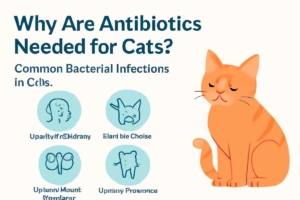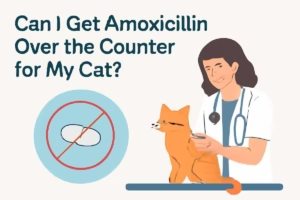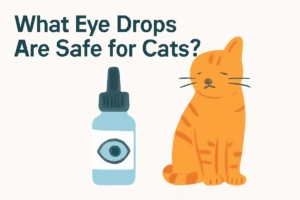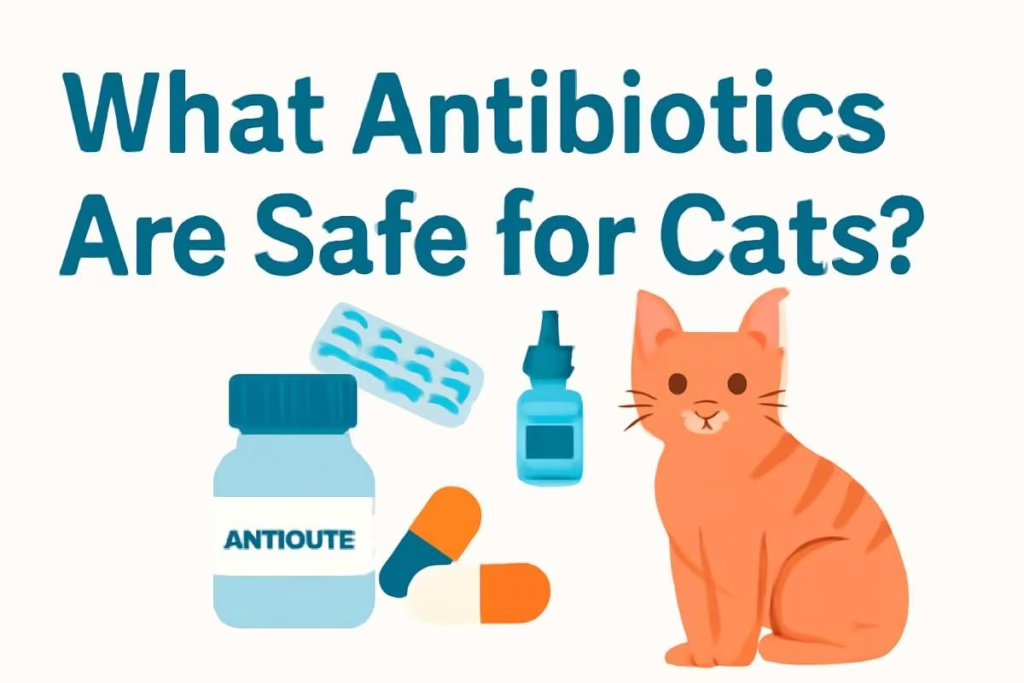As a cat owner, it’s essential to know which antibiotics are safe for your feline friends and how to use them properly. Antibiotics can be life-saving in the case of bacterial infections, but improper use or incorrect antibiotics can have serious consequences. In this guide, we’ll explore the safe what antibiotics for cats, their uses, side effects, and important considerations. If you’re asking what antibiotics can a cat take or how much are cat antibiotics, read on to find the answers and more.

Why Are Antibiotics Needed for Cats?
Common Bacterial Infections in Cats
Antibiotics are prescribed to treat various bacterial infections in cats. Some of the most common conditions that might require antibiotics include:

-
Upper Respiratory Infections (URIs): Cats, especially those in shelters, are vulnerable to respiratory infections. Symptoms include sneezing, coughing, and nasal discharge.
-
Urinary Tract Infections (UTIs): Cats can develop UTIs, leading to painful urination and blood in the urine.
-
Skin Infections: Bacterial infections caused by cuts, scratches, or abscesses.
-
Gastrointestinal Infections: Bacteria like Salmonella and Campylobacter can cause vomiting, diarrhea, and dehydration in cats.
-
Dental Infections: Bacteria can spread to a cat’s teeth or gums, causing abscesses and pain.
Antibiotics work by either killing or inhibiting the growth of bacteria, which helps the body heal naturally. However, they should only be used when necessary and under a vet’s supervision.For example, Amoxicillin for Dogs and Amoxicillin for Puppies are used for similar conditions in dogs, showing its broad-spectrum effectiveness.
What Antibiotics Are Safe for Cats?
1. Amoxicillin
What Antibiotics Can a Cat Take? Amoxicillin is a broad-spectrum antibiotic commonly prescribed to cats. It is effective against a range of bacterial infections, including respiratory and skin infections.
-
Uses: Treats dental infections, UTIs, respiratory issues, and soft tissue infections.
-
Precautions: Some cats may experience gastrointestinal upset, including vomiting or diarrhea.
2. Clavamox (Amoxicillin + Clavulanic Acid)
Clavamox is an enhanced version of amoxicillin. It works against a wider range of bacterial infections by adding clavulanic acid, which helps fight resistant bacteria.
-
Uses: Commonly prescribed for urinary tract infections, dental infections, and skin infections.
-
Precautions: Similar to amoxicillin, it can cause upset stomach, but it’s generally well-tolerated.
If you’re considering this for your dog, you may find useful insights in this Clavamox Dosage for Dogs guide.
3. Doxycycline
Doxycycline is a tetracycline antibiotic often used for respiratory infections and tick-borne diseases.
-
Uses: Effective for treating Lyme disease, pneumonia, and other infections caused by bacteria like Rickettsia and Chlamydia.
-
Precautions: Doxycycline can irritate the stomach, so it’s often recommended to give it with food. Avoid use in cats with liver issues.
4. Cefalexin
Cefalexin is a cephalosporin antibiotic that works by breaking down the cell walls of bacteria.
-
Uses: Effective for treating skin infections, soft tissue infections, and some urinary tract infections.
-
Precautions: Some cats may experience mild gastrointestinal issues, but it’s generally safe for short-term use.
5. Enrofloxacin (Baytril)
Enrofloxacin is a fluoroquinolone antibiotic used for serious infections in cats.
-
Uses: It treats severe bacterial infections such as pneumonia, sepsis, and certain resistant bacterial infections.
-
Precautions: It is a potent drug and should be used under strict veterinary guidance, as it can cause side effects like nausea, changes in appetite, or even kidney toxicity in certain cats.
6. Other Antibiotics:
-
Metronidazole: Often used for gastrointestinal infections or inflammatory bowel disease.
-
Tylosin: A good choice for chronic gastrointestinal issues or respiratory infections.
-
Nitrofurantoin: Commonly used for urinary tract infections.
Can I Get Amoxicillin Over the Counter for My Cat?
Can I get amoxicillin over the counter for my cat? The simple answer is no. Amoxicillin and other antibiotics should only be obtained through a veterinarian’s prescription. Over-the-counter medications, particularly human-grade antibiotics, are not safe for cats and can lead to harmful side effects. Always consult your vet for proper diagnosis and treatment. check out the article Amoxicillin for Puppies.

How Much Are Cat Antibiotics?
How much are cat antibiotics? The price of antibiotics for cats varies depending on the medication, dosage, and your veterinarian’s fees. On average, antibiotics can cost anywhere from $10 to $50 for a typical 7 to 14-day course of treatment. Some specialty antibiotics, like Baytril (enrofloxacin), may cost more due to their potency and need for careful administration.
Side Effects: Do Antibiotics Make Cats Sleepy?
Do antibiotics make cats sleepy? While it’s not typical for antibiotics themselves to make cats sleepy, the infection they are treating can cause lethargy. Additionally, some antibiotics like doxycycline and enrofloxacin may have sedative side effects. If your cat becomes unusually drowsy or exhibits other signs of illness, contact your vet.or more on this, you can refer to Doxycycline Dosage Chart for Dogs.
What Antibiotics Are Used to Treat Pneumonia in Cats?
Pneumonia in cats is a serious condition that can be treated with specific antibiotics. Enrofloxacin (Baytril) and Doxycycline are two commonly prescribed antibiotics to treat pneumonia caused by bacterial infections.
-
Enrofloxacin is used for severe or resistant cases of pneumonia.
-
Doxycycline is typically used for bacterial infections like Chlamydia or Mycoplasma.
What Eye Drops Are Safe for Cats?
What eye drops are safe for cats? Not all human eye drops are safe for cats, and some can cause irritation or damage to their sensitive eyes. Here are some eye drops and ointments that are generally safe for cats:

-
Ofloxacin Eye Drops: Often prescribed to treat bacterial eye infections in cats.
-
Tobramycin Eye Drops: Used for treating bacterial conjunctivitis and other eye infections.
-
Erythromycin Ophthalmic Ointment: This antibiotic ointment is used for treating eye infections caused by bacteria in cats.
Can You Use Human Eye Drops in Cats?
Can you put human eye drops in cat’s eyes? The short answer is no, you should never use human eye drops in cats unless specifically directed by a veterinarian. Some human eye drops contain ingredients that can be toxic to cats or cause irritation to their eyes.
Can You Use Triple Antibiotic Ointment on Cats’ Eyes?
Can you use triple antibiotic ointment on cats’ eyes? No, triple antibiotic ointments, like Neosporin, are not recommended for use in cats’ eyes. These ointments can cause irritation or damage to your cat’s eyes and should only be used when prescribed by a vet for specific infections.
What Kind of Ointment Is Safe for Cats?
When it comes to topical treatments, it’s essential to choose ointments specifically designed for cats. Some ointments may be safe, including:
-
Mupirocin Ointment: This ointment is safe for treating minor skin infections caused by bacteria. It should be used under the guidance of a veterinarian.
-
Erythromycin Ointment: Safe for bacterial skin infections or eye infections, but should only be used as directed by a vet.
Is Mupirocin Ointment Safe for Cats?
Is mupirocin ointment safe for cats? Mupirocin is a topical antibiotic that is generally safe for cats when used to treat skin infections. It works by stopping the growth of bacteria on the skin. However, it should only be used on the advice of a veterinarian.
Is Ofloxacin Safe for Kittens?
Is ofloxacin safe for kittens? Ofloxacin eye drops are generally safe for kittens if prescribed by a veterinarian. It is an antibiotic used to treat eye infections, and your vet will determine the appropriate dosage based on the kitten’s age and weight.
How Long to Use Ofloxacin Eye Drops for Cats?
How long to use ofloxacin eye drops for cats? The typical duration for using ofloxacin eye drops for a cat is about 7 to 14 days, depending on the severity of the infection. However, always follow your vet’s instructions and complete the full course to prevent antibiotic resistance.
How Long Will My Cat Have Diarrhea After Antibiotics?
How long will my cat have diarrhea after antibiotics? Diarrhea is a common side effect of antibiotics as they can disrupt the natural bacteria in the gut. Typically, diarrhea lasts 1 to 2 days after starting antibiotics. However, if the diarrhea persists for longer than 48 hours, consult your vet.
How Long to Use Tobramycin Eye Drops for Cats?
How long to use tobramycin eye drops for cats? The typical duration of using tobramycin eye drops for cats is about 7 to 10 days, but it depends on the severity of the infection. Always follow your veterinarian’s guidelines for the most effective treatment.
Conclusion
In conclusion, it is vital to consult with your veterinarian before giving your cat any antibiotic. What antibiotics are safe for cats depends on the type of infection and the specific needs of your feline companion. Antibiotics like amoxicillin, Clavamox, doxycycline, and Baytril are safe and effective when prescribed by a vet. Always avoid using human medications or over-the-counter antibiotics without professional guidance, as these can harm your cat’s health.
What antibiotics are safe for cats are a crucial tool in treating bacterial infections in cats, but they must be used properly. If you ever have concerns about your cat’s health, antibiotic treatment, or possible side effects, don’t hesitate to reach out to your veterinarian for advice. Safe antibiotic use ensures your cat’s health and well-being, so always follow your vet’s guidance to keep your furry friend happy and healthy.


